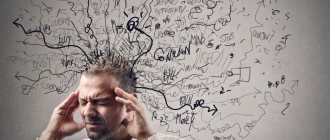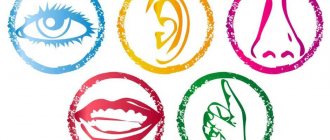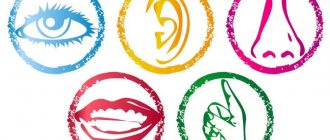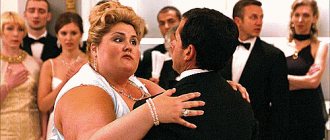Reading emotions in the interlocutor's face
Each of us, at least once in our lives, has found ourselves in a situation where we wouldn’t mind giving half a kingdom for the opportunity to read the thoughts of our interlocutor. Unfortunately, we do not always correctly interpret this or that facial expression, eyes, facial expressions of another person. Meanwhile, there is even a special science - physiognomy, which studies how thoughts and feelings are reflected in appearance. Of course, this can only be called science conditionally - rather a teaching, but a very, very interesting one. And we have something to learn from it.
Important skill
The ability to see the connection between a person’s thoughts and facial expressions is important not only for intelligence officers, but also for us, ordinary law-abiding citizens. Knowledge of the basics of physiognomy can be useful in many situations. For example…
- In a relationship between a man and a woman . When a feeling arises between young people, the ability to read thoughts in the face helps to better understand your loved one, not invent anything unnecessary, not make mountains out of molehills, and not worry about trifles. And in family relationships, knowledge of physiognomy eliminates incorrect reactions to words and related complications.
- In relationships with teenage children . Almost every family experiences the difficulties of a son or daughter's transition. At the age of 13-14 years, when the psycho-physics of a growing child changes, when he begins to move away from his parents, not to let them into his inner world, contact is broken, mutual understanding disappears. Parents often complain that their son or daughter is lying or hiding something. This is where the ability to read faces comes in handy, and thus know what is going on in the head of an over-aged child.
- When communicating with a small child . If a baby is just learning to talk, he cannot always explain what is bothering him. But almost any mother in such a situation demonstrates the skills of a psychic - she easily guesses and correctly interprets all the feelings that are reflected on the child’s face. It must be admitted that dads succeed in this to a much lesser extent.
- At work, in communication with superiors or subordinates . It is not customary to openly express emotions here. You can guess the hidden reasons for certain statements by observing the employee’s facial expression.
- In business, in communication with partners . In this area, being a subtle psychologist is simply necessary. During business negotiations, when discussing projects, concluding contracts, the ability to feel the interlocutor is as important as the ability to think analytically and quickly calculate all risks.
- And in many other situations that arise in everyday life, be it communication with the class teacher of a schoolchild, or with a tax inspector, or with a lawyer conducting divorce proceedings, when a quick and correct reaction is required.
Fatigue
An obvious sign that a person is feeling tired and fatigued is half-open eyelids
. The eyebrows are often raised upward in an attempt not to close the eyes. Fatigue is caused by exertion without sufficient rest.
In primates, especially the more intelligent apes, facial expressions of fatigue are similar to those in humans. When primates are preparing to enter into conflict, or are already involved in conflict, they evaluate their chances of success by how the enemy carries himself, as well as closely studying his energy level
. The expression of fatigue on his face means that the other party will be less afraid.
Human primate abilities
The person also shows their physical energy level
by facial expression. In the same way, other people will evaluate our abilities at the moment.
Hard Science
Correctly deciphering the “language” of facial expressions is quite a difficult task, especially at first.
Firstly , many interlocutors are deliberately trying to prevent this. They watch their facial expressions and do not show emotions. And no matter how hard we try to guess what’s behind this “unclouded surface,” it’s all in vain. If a person has good self-control, he is unlikely to make a mistake.
Secondly , it is not always possible to guess what caused a particular emotion. For example, when you enter your boss’s office on his call, you see that he is frowning and looking from under his brows. This facial expression clearly indicates that he is not experiencing the best feelings right now. And you immediately take it personally: he is dissatisfied with you, you are threatened with a reprimand, and you begin to frantically remember your own sins and hastily come up with self-justifications. Meanwhile, it may turn out that the manager’s gloomy mood is not connected with you at all. Perhaps his new shoes are too tight for him, or his child got a bad grade again, or his wife demanded a new fur coat, and he was just thinking about this and did not have time to wipe the angry expression from his face, because you entered the office too abruptly.
Thirdly , in order to correctly interpret emotions, you need to remember that the perception of reality is influenced by a huge number of factors. This includes upbringing, education, environment, occupation, and the gender of the person itself. It is known that it is much easier to read feelings on a woman’s face than a man’s.
So in order to master the techniques of physiognomy, you will have to try hard. Watching people. Ask questions and at the same time study the reaction. Evaluate your speaking style. Notice all the nuances that will help you accurately guess thoughts and feelings.
What emotions are there?
Photo by Andrea Piacquadio: Pexels
First, a little hardware. Feelings are always characterized by attachment to a specific object or situation. That is, there is some kind of cause-and-effect relationship. A spider has appeared on the wall of the room, so you feel afraid. This feeling.
Emotions arise on their own, regardless of the circumstances. This is precisely a subjective attitude and an independent evaluative reaction of the psyche. In this case, you may experience fear for no good reason. For example, in case of a panic attack.
Emotions are somewhat weaker than feelings in sensations and visual manifestations. In principle, you may not even show that you are surprised or sad. Feelings are always visible on the face, as they are almost impossible to hide. There are 7 basic emotions on which more complex sensations are built:
- fear;
- anger (rage, anger);
- contempt;
- joy (happiness, delight);
- astonishment;
- sadness (longing, sadness);
- disgust.
How to learn to read people?
These are just the simplest concepts. In reality, you are extremely rarely able to clearly determine which specific emotion in its pure form has currently captured your consciousness. Most often, the base is mixed together, like paints in a palette. As a result, complex emotions arise such as:
- tension;
- shyness;
- excitement;
- anxiety;
- suspicion;
- curiosity;
- pride;
- light sadness, etc.
An entire section of practical psychology—Gestalt therapy—is devoted to the study of human emotions. Even the database list is not the same everywhere. Some increase it by adding borderline positions, while others reduce it by including disgust or contempt in the list of component perceptions.
Reading a person like a book
Reading in the eyes
We all remember the words of the classic that the eyes are the mirror of the soul. An experienced person can easily guess feelings from the eyes. Women manage this with particular ease - a fleeting glance is generally enough for them to assess a man’s state of mind without betraying themselves in any way.
And, according to psychologists, the eyes cannot lie. However, you can learn to skillfully hide the truth, as well as recognize a lie.
So, here are some tips on how to perceive certain eye movements.
- A wandering gaze indicates a reluctance to get closer. If the other person catches your eye from time to time, it means that he wants to make eye contact and is in a constructive mood. An unblinking stare is often a sign of aggression, a desire to violate your personal space. However, if we are talking about relationships between a man and a woman, then, on the contrary, an open, direct gaze means interest and a desire to continue acquaintance.
- If a person turns his eyes to the right , it means he wants to remember something. If he looks to the left and then up and also starts rubbing his eyes, scratching his nose or forehead, touching his chin or ears, he is clearly stalling for time, trying to somehow get out of the situation, come up with an excuse, in a word, lie. Frequent blinking also indicates this. If the interlocutor looks at the bridge of your nose, he is in a businesslike mood. A glance directed at the neck is acceptable for friends and good acquaintances. If your counterpart glances lower, this may mean that his interest in you is far from platonic.
- Dilated pupils are usually interpreted as evidence of excitement and interest. Narrowed - as a manifestation of evil feelings. But here everything is not so simple, because the pupils react to light, dilating in the dark and constricting in bright light.
Assessing a smile
Usually we regard a smile as a manifestation of goodwill, sincerity, and openness. But not every smile reflects these feelings. That's what psychologists say.
- If a person smiles, but at the same time his eyes remain wide open , he is being hypocritical, pretending to be happy, but in fact experiencing the opposite feelings. After all, a sincere smile implies narrowed eyes in the rays of wrinkles.
- If the smile does not leave your face , this should also alert you. Perhaps the interlocutor is trying his best to please you, to earn your approval, while you are critical of him.
- A crooked smile indicates an attempt to hide nervousness.
- And there is also a so-called snake smile . This is when your eyes are properly squinted, and your mouth reaches to your ears, and you begin to tremble nervously and want to recoil from the owner of such a smile. Because he's clearly not sincere with you or up to something.
- If a counterpart raises his eyebrows while smiling, he is ready to obey; if he lowers them, he demonstrates his superiority.
- One raised eyebrow plus a slightly crooked smile is a signal of mistrust.
Interpreting facial expressions
- Wide open eyes, raised eyebrows, wrinkles on the forehead, a smile - this is how sincere joy or surprise can be manifested.
- A flushed blush, moistened eyes, a bitten lip - a person feels embarrassed.
- A flushed face, a downcast gaze, knitted eyebrows, tightly compressed lips are a sign of shame.
- A flushed face, tightly compressed lips, a stern look - a person is angry.
- A top-down look, raised eyebrows and chin - a person signals his own superiority.
© Ilyina Natalia, BBF.RU
Facial expression: what can be read from your eyebrows
A quick raise of the eyebrows is a sign of surprise. Your eyes open wide so you can see what's happening clearly, and your eyebrows rise to make you feel better. This is how we react when we want to attract someone's attention or show affection. By raising your eyebrows, you show the other person that you are not a threat to them. This gesture can also signal disbelief or interest in the conversation.
Raising just one eyebrow indicates slight surprise, understanding, or curiosity. On the other hand, if this movement is slow, lasts several seconds and is accompanied by a tilt of the head, it signals resistance, opposition, protest. The face then displays the message: “I am surprised by your behavior.” If you raise your eyebrows, lower your head and eyelids, purse your lips, and turn your body slightly, you are expressing even stronger disapproval: “I want to cut off all contact with you.” In contrast, a person who is overcome by anger may react in two ways: by opening their eyes wide and either raising or lowering their eyebrows. In both of these cases, it is also a clear attitude towards confrontation.
See also: Manipulation methods - 5 techniques for influencing people
Facial expression
General information and definitions
Physiognomy is the art of reading a person by his external signs, in particular by his face, his expression, features and facial expressions. You can determine both internal qualities and some psychological data, as well as health status. This method cannot be called completely scientific, but many are very seriously interested in it due to its certain validity. Facial expressions are facial expressions in which a person reveals his inner sensations, experiences, feelings, mood, emotions and other spiritual qualities. Gestures are body movements, most often with the hand/hands, that accompany or replace the words of the individual performing them. Posture is the position of the body. A person sits, stands or lies the way he likes/convenient/comfortable.
Gestures, postures, facial expressions - all this plays an important role in people's lives. Not a single person can live without them, and therefore, if you learn to recognize them correctly, life will become easier and more interesting. Facial expressions and gestures in communication are used everywhere and automatically; not everyone is able to control them. Thanks to this, more observant and attentive individuals have the opportunity to study people.
Reactions
Human facial expressions manifest themselves in different ways, and most often they can be seen in human emotions. The latter, in turn, are shown in reactions. Depending on their manifestation, you can find out what a person experiences from the information received. The difficulty is that some are afraid, others don’t want to, and still others are embarrassed to show their own emotions. Because of this, you will have to have time to notice the quick, involuntary reaction that appears very first. It is often almost impossible to completely control it, especially for an unprepared person. Therefore, you can determine the real feelings of your interlocutor, which he will most likely remove from his face in seconds, if you act quickly and extremely carefully.











